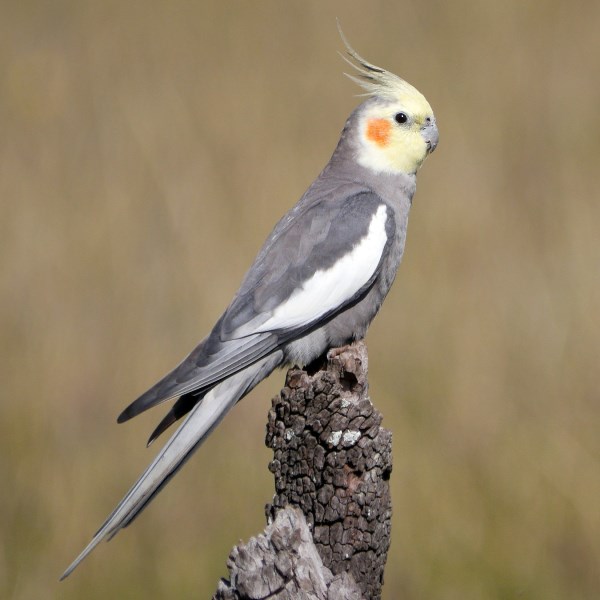Cockatiels, especially males, can learn to speak and they are very good at learning to whistle. Although they can be noisy, cockatiels don’t have a loud screeching voice like other members of the cockatoo family.
Cockatiels
These little birds have a reputation as a gentle and docile bird. They are very affectionate and often like to be petted and held, though they’re not necessarily fond of cuddling. Instead, they simply want to be near their owner and will be very happy to see you.
You will also find cockatiels to be playful and active. While they vocalize and whistle, they are not as loud as some other parrots. The males are thought to be better at mimicking speech and whistles. Female cockatiels are quite good at mimicry, though. Either sex may pick up and repeat sounds from your house, including alarm clocks, phones, and even wild birds outside.
Though they’re generally friendly, an untamed cockatiel can nip. This behavior can be prevented at an early age by ignoring bad behavior. Never scold the bird because this can cause him to become too timid around people. They aim to please, so reward good behavior and disregard the bad.
Cockatiel Colors and Markings
The wild cockatiel has a gray body with a yellow face and crest and orange cheek patch. The colors on the face are brighter and more vivid in the male, and the female has bars on the underside of the tail feathers.
Since they are bred in captivity for pets, several color mutations have been establish over the years. They are the most common establish variation, which includes:
Albino: They lack feather pigmentation.
Lutino: A white bird with a yellow mask, orange cheeks, and red eyes.
Pied: The colors typical of a wild cockatiel are replaced with a yellow or off-white color.
Pearl, laced, or opaline: A spotting of various colors that creates tiny “pearls” along with the feathers.
Cinnamon, fawn, or Isabelle: The grey feathers have more of a brown or warm tan color.
Silver: There is both a recessive silver and dominant silver cockatiel mutation. In the recessive, the feathers have a cool gray color and the birds have red eyes. Dominant silver cockatiels will have a warmer tone and dark eyes.
Other mutations include emerald, cream face, pastel face, whiteface, and yellow cheek cockatiels. The differences between males and females vary in different color variations. They can sometimes be hard to distinguish, especially in young birds.
Caring for Cockatiels
The cockatiels birds they are good company for each other, but they usually will not bond as well as with their owners or mimic speech and sounds. A single bird is fine as long as you spend a significant amount of time interacting with the cockatiel daily. If your lifestyle doesn’t allow this, a pair of birds will prevent loneliness and self-harming behavior.
These birds are naturally messy, and they naturally produce a powder on their feathers. It is use in grooming and may leave a powdery coating on cages and accessories. Regular cleaning is necessary and many cockatiel cages come with a removable bottom tray to make the task easier.
Cockatiels are active and playful and should have a large cage. Opinions on the minimum size vary, but a good rule of thumb is at least 20 inches square and 26 inches tall.
The spacing on the cage bars should be no more than 3/4-inch because any larger will create a safety hazard. Horizontal cage bars offer the best opportunity for the bird to climb and much-needed exercise. There should be space to place at least a couple of perches at different levels with enough space to comfortably move between them.
You will want to clip your cockatiel’s wings and nails at least twice a year. You must learn to do it properly because these small birds can bleed to death. If you’re uncomfortable with this, an aviary veterinarian or breeder can do it for you.
Cockatiels are subject to a few household dangers. Avoid placing the bird’s cage in drafty areas or where he can be expose to cooking fumes like that from Teflon cookware. Both of these are know to make cockatiels sick.
Feeding Cockatiels
Variety is the key to a healthy diet for any parrot, including the cockatiel. Seeds can be a nutritious part of the diet, but they are high in fat so should only make up a portion of the diet. Some experts recommend no more than about 30 percent of the bird’s diet should be a seed.
Pellet diets are often a good choice for birds as they are nutritionally balance, and birds can’t pick out their favorite seeds and leave the rest. However, with both seeds and pellets, a wide variety of other foods should complement the diet.
To keep your cockatiel healthy, offer a variety of fresh vegetables and fruit. Persistence might be need before your bird will try new foods, particularly if they are accustom to an all-seed diet. Proteins such as hard-boil egg, legumes, and cook meats can be offer in moderation. Sprout seeds are also an excellent way to add variety to your bird’s diet.

